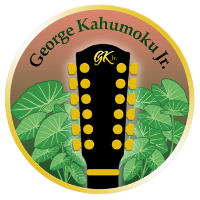
About Uncle George by Jeff Kaliss
An introduction by Nancy Kahumoku: Here is a piece written about Uncle George by Jeff Kaliss, originally published on guitarplayer.com, a couple of years ago. Jeff’s website can be seen at www.jeffkaliss.com.
“Even when I’m in the studio, I’m imagining my whole ohana or family playing with me,” he says. “I look on myself as being the leftover—the DNA—of all the culture.”
As a small boy in the 1950s, Kahumoku listened to his great grandfather and other relatives vocalizing on the back porch to the accompaniment of guitars tuned to D-Wahine [D, A, D, F, A, C, low to high]. Such open tunings are a foundation of the slack key style, but for many years every ohana guarded its own tuning closely, effectively keeping much of the music private. Nonetheless, the legendary Gabby Pahinui released the first commercial recordings of slack key guitar in the mid ’40s, and, earlier in the century, a few aspects of Island musical culture had been successfully exported—including pop tunes, the hula, the ukulele, and the use of slides on ukuleles and guitars.
Of course, slack key guitar is no longer esoteric, and, for the past ten years, Kahumoku has disseminated slack key tunings, techniques, and other aspects of the culture at his slack key guitar Workshops on Maui, as well as producing instructional DVDs with his son Keoki Kahumoku. Instructional materials are also available from Keola Beamer, Ledward Kaapana, and elder veteran Ray Kane, who, along with a host of others, have released albums of traditional and original slack key material on the Santa Cruz-based Dancing Cat label. Mixed into the track lists are hymns, ragtime novelties from the ukulele-crazy ’20s, lounge numbers from the ’50s and ’60s, and an occasional rock reference—all of which reflect the range of the players’ influences and career experiences.
On Maui, the guitarists are showcased in a weekly Masters of Hawaiian Slack Key Guitar Series at the Ritz-Carlton at Kapalua and the nearby Napili Kai Beach Resort. Kahumoku’s genial sets as host are interspersed with his tales of island life—his “talking story”—and with hula danced by his buoyant wife, Nancy. Compilations from this series, assembled by Kahumoku and fellow guitarist and ukulele player Daniel Ho, have garnered Grammys for Best Hawaiian Music Album two years in a row.
Manifest in these performances and recordings are approximately 20 open tunings (each chosen to match the vocal range of the singer), varieties of instrumentation (though many players work solo), and the varying tonal and dynamic demands of the repertoire. When playing with an ensemble, Kahumoku favors the Taro Patch F tuning [C, F, C, F, A, C, low to high] that is suggestive of the traditional role of the vegetable taro in Hawaiian creation myths, and also of Kahumoku’s second career as a farmer.
The primal theme of creation is also evoked by the i’i (or vibrato) in traditional Hawaiian singing, and by the manner in which the Islanders retrofitted guitars that were left behind in the mid-19th Century by Mexican vaqueros who had been brought in to help manage imported cattle. In short, the Islanders slackened the standard tunings, setting open chords to the harmonically simple but vibrant pre-European melodies, including chants celebrating the creation and proliferation of the natural world.
Some of the techniques of slack key fingering are thought to mirror the traditional ornamentations of Hawaiian vocalists. They include hammer-ons, pull-offs, sliding on a single string or two strings—often in parallel thirds, fifths, or octaves—and slurring, which Kahumoku describes as an “oscillating slide.” Players combine these ingredients to create the most recognizable of slack-key flavors: arpeggiated vamps or turnarounds played on the upper strings, most often over a V7-I or II-V7-I cadence. Additionally, chiming harmonic overtones achieved by gently touching the 5th, 7th, or 12th frets are an evocation of traditional falsetto or leo ki’eki’esinging.
But what Kahumoku hears as special in the slack key style are its strong foundational bass lines—alternating octaves or fifths on the sixth, fifth, and/or fourth strings that support the harmonies and melodies played simultaneously on the higher strings. Using a ProPik on his thumb and a John Pearse on his index finger, Kahumoku rounds out the satisfying fullness of slack key with rhythm fills, often on the fourth and third strings. Most players work this multi-timbral magic on 6-string instruments, but it sounds even more impressive on Kahumoku’s 12-string guitars, which include a black graphite RainSong WS3000 (customized with a wider neck to fit his sturdy fingers), an A. Davis J12MCS jumbo (customized with engraved hibiscus fret markers and koa and abalone trim), and a Taylor 855ce Jumbo. Kahumoku plays the RainSong when composing and teaching, but the A. Davis is his main performance instrument.
“It has a full sound, as well as the thumping bass I love,” he says. “Also, its string pairs are set far enough apart for easier picking.”
Both instruments have been fitted with L.R. Baggs pickups (the RainSong also has a second pickup taken from a Larivée), and are strung with light- or extra-light-gauge Elixir Strings. Kahumoku strings the Taylor with D’Addarios. The Taylor is fitted with the company’s Expression System pickups.
Over the past few decades, slack key guitar music has served as the soundtrack to a resurgence of pride in island heritage, including the musically sophisticated legacy of Liliuokalani, the reigning queen of Hawaii until the U.S. placed her under military house arrest in 1895. Kahumoku’s lovely and virtuosic slack key recording of the Queen’s most famous composition, “Aloha ’Oe,” is an effective summons to other musicians willing to explore beyond stereotypes and assumptions in search of a subtle and satisfying tradition.
